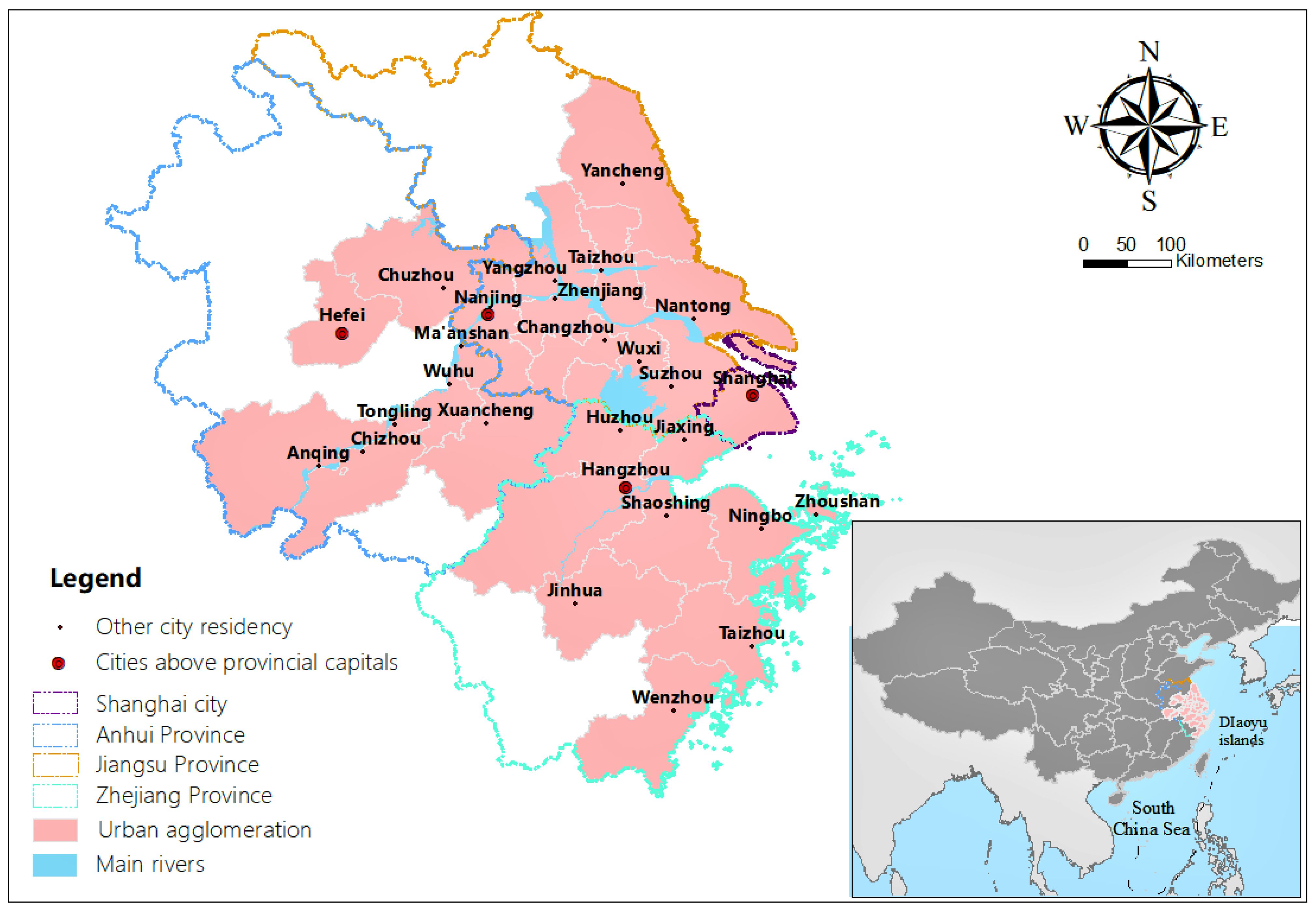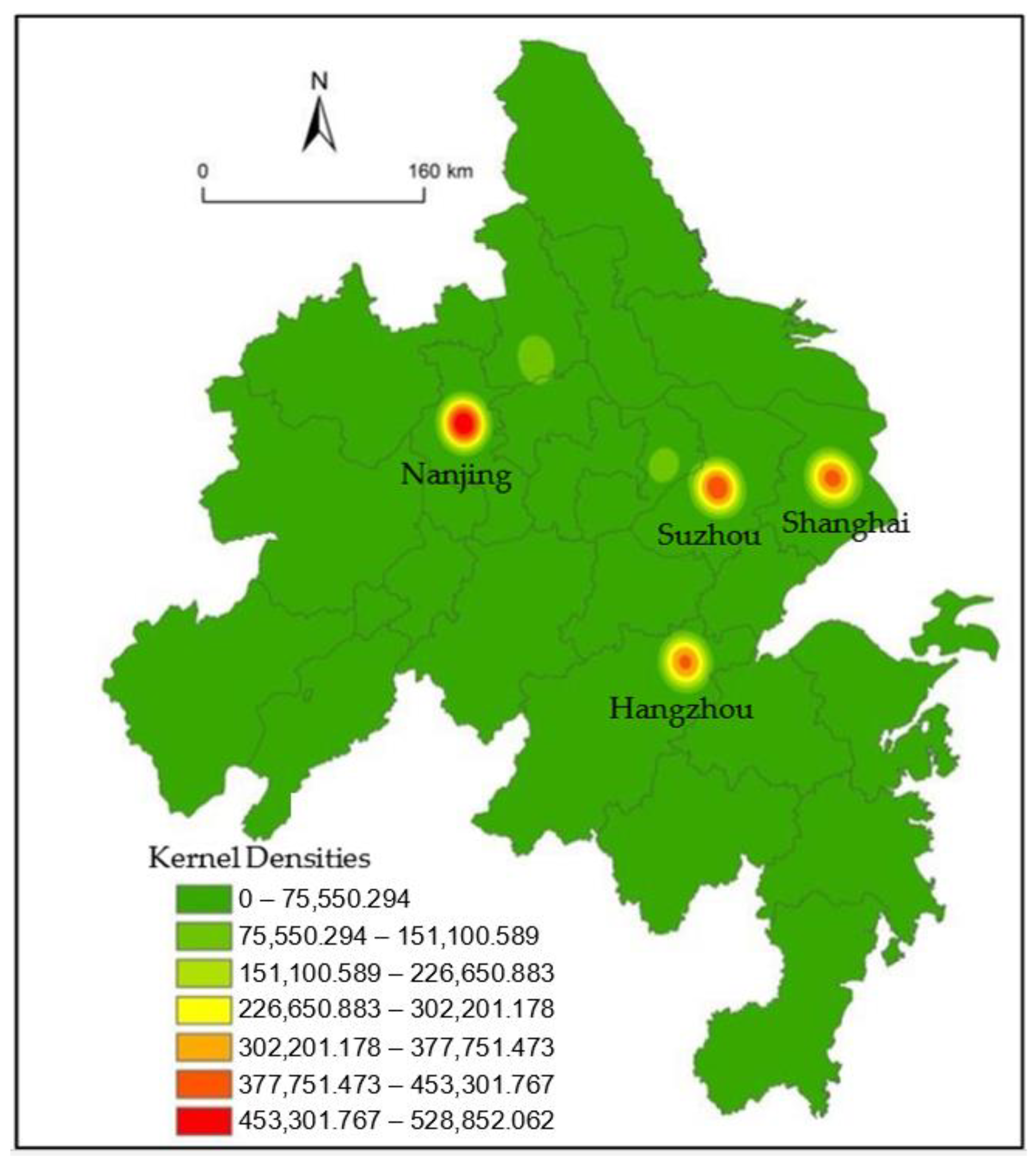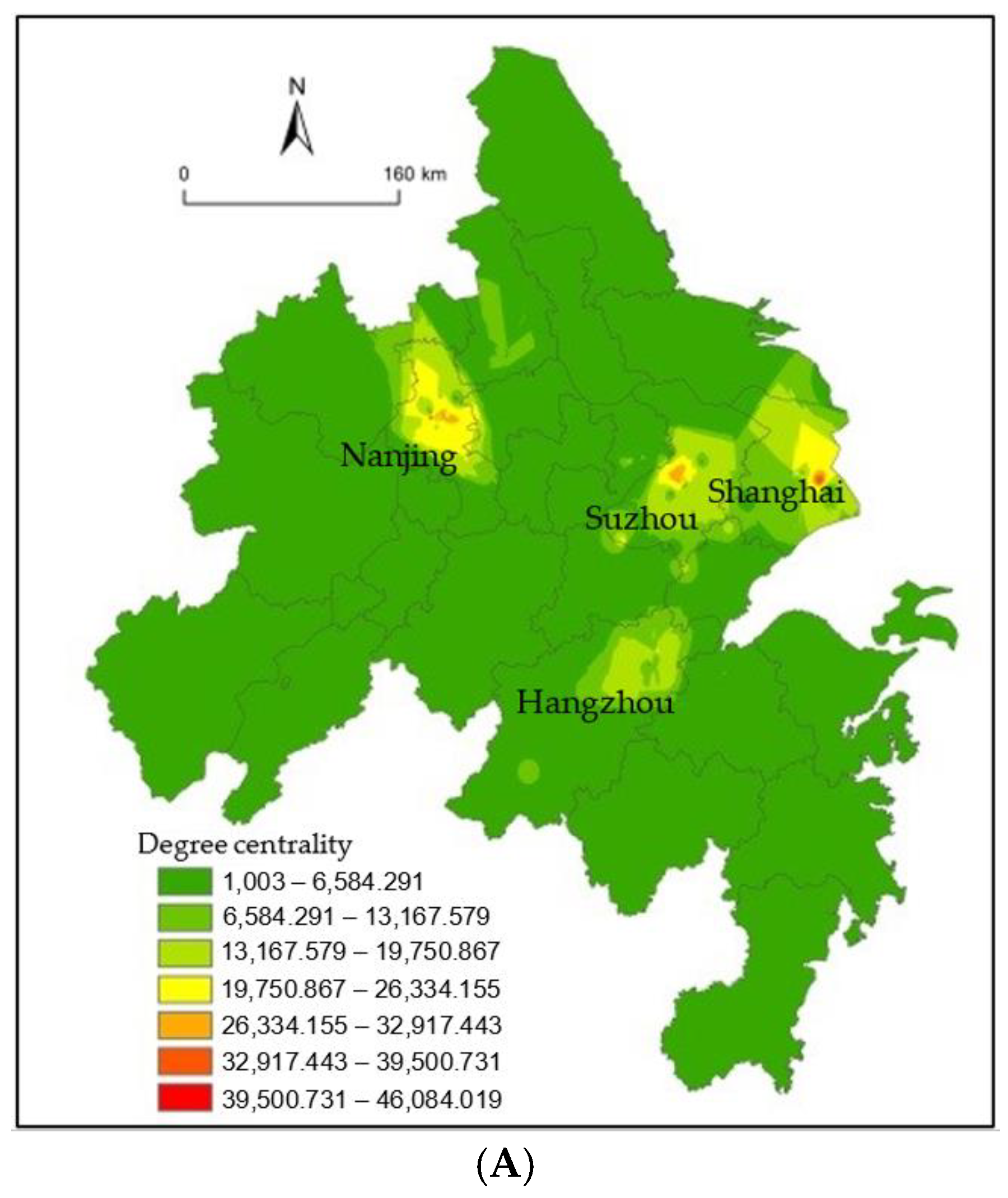Spatial Structure Characteristics of Tourist Attraction Cooperation Networks in the Yangtze River Delta Based on Tourism Flow
Abstract
:1. Introduction
2. Materials and Methods
2.1. Study Area
2.2. Data Collection and Analysis
2.3. Research Methods
2.3.1. GIS Spatial Analysis Method
2.3.2. Social Network Analysis
3. Results and Discussion
3.1. Kernel Density Analysis
3.2. Nodal Structure Analysis
- (1)
- Super-scale condensed subgroups
- (2)
- Larger-scale condensed subgroups
- (3)
- Larger-scale condensed subgroups
- (4)
- Larger-scale condensed subgroups
- (5)
- General-scale condensed subgroups
- (6)
- General-scale condensed subgroups
- (7)
- Small-scale condensed subgroups
- (8)
- Small-scale condensed subgroups
4. Conclusions
4.1. Findings
4.2. Limitations
Author Contributions
Funding
Institutional Review Board Statement
Informed Consent Statement
Acknowledgments
Conflicts of Interest
References
- Baggio, R. Collaboration and cooperation in a tourism destination: A network science approach. Curr. Issues Tour. 2011, 14, 183–189. [Google Scholar] [CrossRef]
- Yang, Y. Understanding tourist attraction cooperation: An application of network analysis to the case of Shanghai, China. J. Destin. Mark. Manag. 2018, 8, 396–411. [Google Scholar] [CrossRef]
- Wäsche, H.; Dickson, G.; Woll, A. Quality in regional sports tourism: A network approach to strategic quality management. J. Sport Tour. 2013, 18, 81–97. [Google Scholar] [CrossRef]
- Fernandes, G. Cooperation and competitiveness in tourism sustainability. Positioning of tourist actors in the Serra da Estrela Natural Park in Portugal. In International Conference on Tourism, Technology and Systems; Springer: Singapore, 2020; pp. 52–65. [Google Scholar]
- Putri, D.A.; Susilowati, M.; Semedi, J.M. Tourist attraction and tourist motivation in the Patuha Mountain Area, West Java. Indones J. Geogr. 2021, 53, 95–102. [Google Scholar]
- Leask, A. Progress in visitor attraction research: Towards more effective management. Tour. Manag. 2010, 31, 155–166. [Google Scholar] [CrossRef]
- Leask, A. Visitor attraction management: A critical review of research 2009–2014. Tour. Manag. 2016, 57, 334–361. [Google Scholar] [CrossRef]
- Sun, J.H. Research on cooperation strategy between government, tourist attraction and travel agency under the background of low carbon. Value Eng. 2019, 38, 18–23. [Google Scholar]
- Nugroho, S.P.; Kurniawati, N.; Sinangjoyo, N.J.; Islami, M.E.N. Potential gastronomy tourist attraction in the area of Alun-Alun Utara Yogyakarta. Tech. Soc. Sci. J. 2021, 22, 630–640. [Google Scholar]
- Napitupulu, J.; Pramono, R.; Saragih, E.L. Determinants of tourist attraction of the heritage tourism. J. Environ. Manag. Tour. 2021, 12, 507–514. [Google Scholar]
- Sthapit, A. Cooperation and collaboration for sustainable tourism: Key to recovery and growth in post-pandemic era. J. Hosp. Tour. Manag. 2021, 2, 5–6. [Google Scholar]
- Baggio, R.; Scott, N.; Cooper, C. Network science: A review focused on tourism. Ann. Tour. Res. 2010, 37, 802–827. [Google Scholar] [CrossRef]
- Jesus, C.; Franco, M. Cooperation networks in tourism: A study of hotels and rural tourism establishments in an inland region of Portugal. J. Hosp. Tour. Manag. 2016, 29, 165–175. [Google Scholar] [CrossRef]
- Park, B.A. Study on the tourist network in Chinese inbound tourist by using social network analysis. J. Hotel. Resort 2017, 16, 135–150. [Google Scholar]
- Zhang, H.; Qin, S.U.; Zhang, Y. Progress in the application of social network analysis in international tourism research. Prog. Geogr. 2019, 38, 520–532. [Google Scholar]
- Kim, K.H.; Lee, Y.T. An analysis of policy paradigm changes in medical tourism policy: Application of policy change model and policy network model. J. Tour. Enhanc. 2021, 9, 39–64. [Google Scholar] [CrossRef]
- Lambert, P.D. Cross-Border Tourism-Policy Coordination in the Pacific Northwest Economic Region. In Canada’s Fluid Borders: Trade, Investment, Travel, Migration; University of Ottawa Press: Ottawa, ON, Canada, 2021; pp. 114–142. 2021. [Google Scholar]
- Panasiuk, A.; Wszendyby-Skulska, E. Social aspects of tourism policy in the European Union. The example of Poland and Slovakia. Economies 2021, 9, 16. [Google Scholar] [CrossRef]
- Wang, K.Y.; Yu, J.; Ning, C.Y. Sustainable Coastal Tourism Policy Selection and Local Resident Satisfaction Assessment. In Proceedings of the 2021 International Conference on Enterprise Management and Economic Development (ICEMED 2021), Nanjing, China, 14–16 May 2021. [Google Scholar]
- Nakamura, A.; Takahashi, H. An exploratory study on policy evaluation of tourism by using agent-based model. In Agents and Multi-Agent Systems: Technologies and Applications; Springer: Singapore, 2021; pp. 231–241. [Google Scholar]
- Azazz, A.; Elshaer, I.A.; Ghanem, M. Developing a measurement scale of opposition in tourism public-private partnerships projects. Sustainability 2021, 13, 5053. [Google Scholar] [CrossRef]
- Frolova, E.; Kabanova, E. Tourist attraction development factors of Russia’s municipalities. Public Adm. Issues 2017, 3, 112–128. [Google Scholar]
- Bramwell, B. Governance, the state and sustainable tourism: A political economy approach. J. Sustain. Tour. 2011, 19, 459–477. [Google Scholar] [CrossRef]
- Mohamed, A.; Akasha, A.; Tham, J.; Albattat, A.R. Tourism marketing and perceived risks impact on attracting Libyan local tourists. Int J. Sci. Technol. Res. 2020, 9, 336–346. [Google Scholar]
- Chen, W.; Qu, H.; Chi, K. Partner selection in China interorganizational patent cooperation network based on link prediction approaches. Sustainability 2021, 13, 1003. [Google Scholar] [CrossRef]
- Hong, T.; Ma, T.; Huan, T.C. Network behavior as driving forces for tourism flows. J. Bus. Res. 2015, 68, 146–156. [Google Scholar] [CrossRef]
- Scott, N.; Baggio, R.; Cooper, C. Network analysis and tourism from theory to practice. In Aspects of Tourism; Channel View Publications: Bristol, UK, 2008. [Google Scholar]
- Silva, D.; Hoffmann, V.E.; Costa, H.A. Trust in tourism cooperation networks: Analysis of its role and linked elements in Parnaíba, Piauí, Brazil. Rev. Bras. Pesqui. Tur. 2020, 14, 9–29. [Google Scholar]
- Jamal, T.B.; Getz, D. Collaboration theory and community tourism planning. Ann. Tour. Res. 1995, 22, 186–204. [Google Scholar] [CrossRef]
- Asero, V.; Gozzo, S.; Tomaselli, V. Building tourism networks through tourist mobility. J. Travel Res. 2016, 55, 751–763. [Google Scholar] [CrossRef]
- Tahmasebi, A.; Zavarnia, M. Network analysis of organizational cooperation in tourism destination management. J. Soc. Stud. Tour. 2020, 8, 277–296. [Google Scholar]
- Gretzel, U.; Yoo, K.H.; Purifoy, M. Online Travel Review Study: Role and Impact of Online Travel Reviews. Laboratory for Intelligent Systems in Tourism, Texas A&M University. Available online: www.tripadvisor.com/pdfs/OnlineTravelReviewReport.pdf (accessed on 21 January 2017).
- Czernek-Marszaek, K.; Marszaek, P. Social embeddedness as a trigger of business tourism cooperation. Argum. Oeconomica 2020, 2019, 341–386. [Google Scholar] [CrossRef]
- Yin, J.; Bi, Y.; Ji, Y. Structure and formation mechanism of China-ASEAN tourism cooperation. Sustainability 2020, 12, 5440. [Google Scholar] [CrossRef]
- Gan, C.; Voda, M.; Wang, K.; Chen, L.; Ye, J. Spatial network structure of the tourism economy in urban agglomeration: A social network analysis. J. Hosp. Tour. Manag. 2021, 47, 124–133. [Google Scholar] [CrossRef]
- Chaderopa, C. Crossborder cooperation in transboundary conservation-development initiatives in southern Africa: The role of borders of the mind. Tour. Manag. 2013, 39, 50–61. [Google Scholar] [CrossRef]
- Schaffer, V.; Lawley, M. An analysis of the networks evolving from an artificial reef development. Curr. Issues Tour. 2012, 15, 497–503. [Google Scholar] [CrossRef]
- Kondrateva, S. Cross-border cooperation programs as tool of the regional tourism development: Case of the Republic of Karelia. Pskov Reg. Stud. J. 2020, 44, 109. [Google Scholar] [CrossRef]
- Kang, C.Y. Internationalization strategy of tourism industry and selective double structure of cooperation in the Kim Jong-un regime. J. Northeast Asian Stud. 2020, 25, 101–125. [Google Scholar] [CrossRef]
- Czernek-Marszaek, K. Social embeddedness and its benefits for cooperation in a tourism destination. J. Destin. Mark. Manag. 2020, 15, 100401. [Google Scholar] [CrossRef]
- Kropinova, E. Transnational and cross-border cooperation for sustainable tourism development in the Baltic Sea Region. Sustainability 2021, 13, 2111. [Google Scholar] [CrossRef]
- Czernek-Marszaek, K. The over embeddedness impact on tourism cooperation. Ann. Tour. Res. 2020, 81, 102852. [Google Scholar] [CrossRef]
- Yang, J.; Yang, R.; Chen, M.H.; Su, C.H.J.; Zhi, Y.; Xi, J. Effects of rural revitalization on rural tourism. J. Hosp. Tour. Manag. 2021, 47, 35–45. [Google Scholar] [CrossRef]
- Jin, S.; Yang, J.; Wang, E.; Liu, J. The influence of high-speed rail on ice–snow tourism in northeastern China. Tour. Manag. 2020, 78, 104070. [Google Scholar] [CrossRef]
- Yang, J.; Bao, Y.; Zhang, Y.; Li, X.; Ge, Q. Impact of accessibility on housing prices in Dalian city of China based on a geographically weighted regression model. Chin. Geogr. Sci. 2018, 28, 505–515. [Google Scholar] [CrossRef] [Green Version]
- Xia, Y.; Ding, Q.; Jing, N.; Tang, Y.; Jiang, A.; Shu, J. An enhanced fault detection method for centrifugal chillers using kernel density estimation based kernel entropy component analysis. Int. J. Refriger 2021, 129, 290–300. [Google Scholar] [CrossRef]
- Asta, D.M. Kernel density estimation on symmetric spaces of non-compact type. J. Multivar. Anal. 2021, 181, 104676. [Google Scholar] [CrossRef]
- Tan, J.; Xie, X.; Zuo, J.; Xing, X.; Liu, B.; Xia, Q.; Zhang, Y. Coupling random forest and inverse distance weighting to generate climate surfaces of precipitation and temperature with multiple-covariates. J. Hydrol. 2021, 598, 126270. [Google Scholar] [CrossRef]
- Wang, H.K.; Chien, C.F. An inverse-distance weighting genetic algorithm for optimizing the wafer exposure pattern for enhancing overall wafer effectiveness. Appl. Soft Comput. 2020, 94, 106430. [Google Scholar] [CrossRef]
- Liu, B.; Songshan, S.H.; Fu, H. An application of network analysis on tourist attractions: The case of Xinjiang, China. Tour. Manag. 2017, 58, 132–141. [Google Scholar] [CrossRef]
- Britt, B.C.; Hayes, J.L.; Musaev, A.; Sheinidashtegol, P.; Parrott, S.; Albright, D.L. Using targeted betweenness centrality to identify bridges to neglected users in the Twitter conversation on veteran suicide. Soc. Netw. Anal. Min. 2021, 11, 1–15. [Google Scholar] [CrossRef]
- Ye, Q.; Xu, X. Determining factors of cities’ centrality in the interregional innovation networks of China’s biomedical industry. Scientometrics 2021, 126, 2801–2819. [Google Scholar] [CrossRef]
- Benckendorff, P. Themes and trends in Australian and New Zealand tourism research: A social network analysis of citations in two leading journals (1994–2007). J. Hosp. Tour. Manag. 2009, 16, 1–15. [Google Scholar] [CrossRef] [Green Version]
- Brandes, U.; Freeman, L.C.; Wagner, D. Social networks. In Handbook of Graph Drawing and Visualization; Tamassia, N., Ed.; CRC Press: Boca Raton, FL, USA, 2014; pp. 803–807. [Google Scholar]
- Meshkova, N.; Sergievskaya, N. Development of the competitive advantages of the enterprise based on the network cooperation. E3S Web Conf. 2020, 220, 01021. [Google Scholar] [CrossRef]
- Borgatti, S.P.; Everett, M.G.; Freeman, L.C. Ucinet for Windows: Software for Social Network Analysis; Analytic Technologies: Harvard, MA, USA, 2002. [Google Scholar]
- Bell, D.C.; Atkinson, J.S.; Carlson, J.W. Centrality measures for disease transmission networks. Soc. Netw. 1999, 21, 1–21. [Google Scholar] [CrossRef]
- Coviello, N.E. Integrating qualitative and quantitative techniques in network analysis. Qual. Market. Resl. 2005, 8, 39–60. [Google Scholar] [CrossRef]





Publisher’s Note: MDPI stays neutral with regard to jurisdictional claims in published maps and institutional affiliations. |
© 2021 by the authors. Licensee MDPI, Basel, Switzerland. This article is an open access article distributed under the terms and conditions of the Creative Commons Attribution (CC BY) license (https://creativecommons.org/licenses/by/4.0/).
Share and Cite
Wang, Y.; Chen, H.; Wu, X. Spatial Structure Characteristics of Tourist Attraction Cooperation Networks in the Yangtze River Delta Based on Tourism Flow. Sustainability 2021, 13, 12036. https://doi.org/10.3390/su132112036
Wang Y, Chen H, Wu X. Spatial Structure Characteristics of Tourist Attraction Cooperation Networks in the Yangtze River Delta Based on Tourism Flow. Sustainability. 2021; 13(21):12036. https://doi.org/10.3390/su132112036
Chicago/Turabian StyleWang, Yuewei, Hang Chen, and Xinyang Wu. 2021. "Spatial Structure Characteristics of Tourist Attraction Cooperation Networks in the Yangtze River Delta Based on Tourism Flow" Sustainability 13, no. 21: 12036. https://doi.org/10.3390/su132112036
APA StyleWang, Y., Chen, H., & Wu, X. (2021). Spatial Structure Characteristics of Tourist Attraction Cooperation Networks in the Yangtze River Delta Based on Tourism Flow. Sustainability, 13(21), 12036. https://doi.org/10.3390/su132112036




